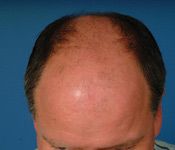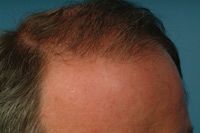- General Dermatology
- Eczema
- Chronic Hand Eczema
- Alopecia
- Aesthetics
- Vitiligo
- COVID-19
- Actinic Keratosis
- Precision Medicine and Biologics
- Rare Disease
- Wound Care
- Rosacea
- Psoriasis
- Psoriatic Arthritis
- Atopic Dermatitis
- Melasma
- NP and PA
- Skin Cancer
- Hidradenitis Suppurativa
- Drug Watch
- Pigmentary Disorders
- Acne
- Pediatric Dermatology
- Practice Management
- Prurigo Nodularis
Article
Not your father's transplant: New techniques make modern hair restoration 'undetectable'
Hair restoration has been revolutionized by new techniques, such as follicular unit transplantation. Modern hair transplants are undetectable, an expert says.

Key Points

"Today, hair restoration is a whole new field unto itself, and surgeons who perform hair restoration are specialists in the field.
"Modern hair restoration is immensely different today than in the past, and in a normal social situation, modern hair transplants will be completely undetectable," he says.


"For example, we can help children who have been burned or injured in an automobile accident, people who have rare inflammatory scarring conditions of the scalp, individuals who have had radiation due to a brain tumor, and women who have undergone cosmetic procedures, such as a brow lift," Dr. Stough tells Dermatology Times.
Follicular unit transplantation
Bobby Limmer, M.D., of San Antonio was largely responsible for the current techniques employed in modern hair restoration surgery.
Follicular unit transplantation (FUT), which has evolved over the past 20 years, involves the removal of a follicular family unit.
The units are composed of one to four hairs. For example, the hairs at the back of the scalp emerge as a tight group consisting of one to four hairs, on average.
"These units can be harvested as a strip, or they can be harvested with very small punches as individual units," Dr. Limmer says. "The latter technique is termed 'follicular unit extraction (FUE).'
"Regardless of the methods that they are harvested, only the follicular family units are placed back into the scalp," Dr. Limmer adds.
According to Dr. Stough, "Both methods require very skilled staff.
"The advantages of the strip method are that with practice, there is very little wasted tissue, and the donor removal process can be achieved very quickly.
"In follicular unit extraction, no linear donor scars are produced. This is because only the follicle itself is removed by a 1 mm circular punch," Dr. Stough adds.
Complications
Both procedures have minimal complications.
Complications from FUT are uncommon, although folliculitis may be seen in a small percentage of patients. Treatment consists of topical and oral antibiotics and, occasionally, antifungal shampoos.
Wide donor scars are quite rare and generally occur with harvest strips greater than 1 cm. Generally, if the strips are kept narrow, the scars are quite narrow, around 1 to 3 mm.
When a patient undergoes multiple procedures with strip harvesting of the donor area, Dr. Stough removes the old scar so the individual is left with one scar of small width, which is often imperceptible.
Patient selection
Generally, men ages 30 years and older are the best candidates for hair restoration surgery.
"For typical male pattern baldness, men under 21 years old should be considered with extreme caution," Dr. Stough says.
"Men age 21 to 30 years of age need to understand the long-term commitment of hair restoration surgery. While they will have a procedure that does work and looks natural, they may need multiple procedures over their lifetime if their baldness progresses.
"We do not have the ability to predict baldness. There is no crystal ball; therefore, as transplant surgeons, it behooves us to take a more conservative approach," he says.





